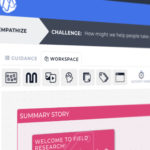How to write a design thinking project brief
There’s a lot of excitement at the start of a design thinking project. You’ve got a problem that needs solving, you’ve got people ready to help you tackle it, now you just want to get started!
But first, to make sure everybody has a shared understanding of the vision for your project – and to help you get the best results from it – you need a project design brief.
In this document, you’ll set out the scope of the project, goals, the timeline you’re working to, who’s involved, and key tasks and requirements. Use it as your ‘north star’, grounding everyone involved in the project in what you’re aiming to achieve.
Did you know that Sprintbase has a huge range of templates built into the platform, to help you move through every stage of your design project? Each one has clear instructions on how to use them for the best results.
Here are our tips on how to put a great project design brief together, and how Sprintbase templates can help you do it.
What to include in your brief
As you can see, the Project Design Brief template on Sprintbase clearly sets out all the information you need to include.
Start by including your How Might We challenge or project focus at the top. (Need help coming up with your HMW? Check out our HMW Generator for inspiration).
Then, together with your team and stakeholders, work through each of the sections of the brief. Here are some things to consider as you go:
Project purpose: Think about the process you went through to define your challenge and explain how you got there. Why is it important right now?
Target users: Who will the results of this project benefit? Who are your customers? Who are your end users? Includes them here.
Project goals: If your project is successful, what will you have achieved? What benefits will this work bring to your customers and wider stakeholders?
Success criteria: How are you going to measure success? What metrics will you use?
Project scope: This is where you can clearly set out the boundaries of your project. What is included and what isn’t? You don’t need to set out all your deliverables, instead use this space to define the outer limits of your project.
Resources: What do you need to make this work happen? Consider all the people who need to be involved, including their names and roles where possible. What other things will you need? Materials? Budget?
Constraints: Set out any obstacles or pressures you anticipate. What will you do to work around them?
Assumptions: What assumptions will you be testing or validating during this project?
Risks: List any risks you can foresee that could have an impact on the project process or outcomes. Do any risks require action from the project or sponsor team? Consider and include how you might mitigate each one.
And remember…
This brief isn’t set in stone. Your project will inevitably evolve as you dive deeper into your challenge, so allow your brief to do the same. Keep coming back to this document and updating it as changes occur, and use it to keep everybody aligned on shifts in direction.
If you’d like to explore how you can use Sprintbase to run design projects that help you find truly creative solutions to real problems, start your free trial today.
More from the blog

How to be a great virtual workshop facilitator
Pretty much every meeting, workshop and conference on the planet is being done virtually right now. But what does it take to be a great virtual facilitator?

How To Move Your Design Thinking Online
Design Thinking has become common currency in many businesses over the last few years, but the practices that make up this approach to the creation of new products and services are rooted in the physical world. Design Thinking practitioners come equipped with whiteboards, Post Its, flip charts and Sharpies, and run workshops in person.

How to secure support for your innovation project
We’ve seen it happen far too many times. A great innovation project gets all the way through to completion, but then it goes nowhere, because it doesn’t have leadership buy-in. Unless a project has true…
Get a free trial
Contact us to get your free trial or to talk about how Sprintbase can help you achieve your remote innovation goals.
Get started





